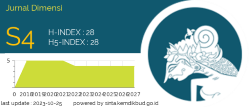EFL STUDENTS’ PERCEPTION ABOUT MACHINE TRANSLATION
Abstract
Machine Translation become as alternative to know the meaning of foreign language. Machine Translation was used to translate word, phrase, sentence, pharagraph. text translation was made as a general description and a consederation to get understanding. Machine Transalation can be used as dictionary, too. It is easier to find word by using Machine Translation rather than dictionary. The purpose of using it; to ensure the meaning, to know the meaning and to be more practice. But, Machine Translation leaded them to a confused situation, because sometimes the grammar and structure were different from what they knew and learned, so it made them confused deciding the correct one. Another effect was making them became lazy to open dictionary, to memorize new words.son their problem on using machine translation covers structure/grammar and several words such as idiom.
Keywords: Machine Translation, Machine Translation Problems, Structure/Grammar Case.
Full Text:
PDFReferences
Ali, A. (2016). Exploring The Problems Of Machine Translation From Arabic Into Englishlanguage Facedby SaudiUniversity Student Of Translation At The Faculty-- Of Arts,Jazan UniversitySaudi Arabia. IOSR Journal of Humanities and Social Science, 21(4), 55–66. http://doi.org/10.9790/0837-2104025566
Arnold, D., Balkan, L., Humphreys, R. L., Meijer, S., & Sadler, L. (1994). Machine Translation: An Introductory Guide. Machine Translation. london: NCC Blackwell Ltd.
Ashari, E. (2015). Patterns of Coding in Conversation Texts of the English Zone. Anglo-Saxon, 6(8), 39–46.
Chan, S. (2015). The Routledge encyclopedia of translation technology. In S. Chan (Ed.) (first, p. 757). London and New york: Routledge, Taylor and Francis Group. http://doi.org/10.4324/9781315749129.ch3
Creswell, J. W. (2014). Research Design: Qualitative, Quantitative, and Mixed Methods Approaches. Research design Qualitative quantitative and mixed methods approaches. http://doi.org/10.1007/s13398-014-0173-7.2
Gupta, S. and. (2014). Machine Translation Approaches and Design Aspects. Http://www.iosrjournals.org/iosr-Jce, 16(1), 22–25.
Hutchins, J. (2003). Machine Translation: General Overview. The Oxford Handbook of Computational Linguistics.
Keegan, S. (2009). Qualitative Research - Good Decision Making Through Understanding People, Cultures and Markets. (David barr and robin J birn, Ed.), Zhurnal Eksperimental’noi i Teoreticheskoi Fiziki. Lomdon & Philadelphia: Marker research in practiceseries. http://doi.org/10.2501/S1470785309201247
Prior, L. (2008). Document analysis. ( lisa m Given, Ed.), The Sage Encyclopedia of Qualitative Research Methods (1st &2nd ed.). london: a sage reference publication. http://doi.org/10.4135/9781412963909
Shalehoddin, & Ashari, E. (2016). “ MOVE ” ANALYSIS IN CLASSROOM INTERACTION ( An Functional Grammar Approach ). Anglo-Saxon, 7(1), 73–81. Retrieved from http://journal.unrika.ac.id/index.php/jurnalanglo-saxon/article/view/512
Shuttleworth, M., & Cowie, M. (2014). Dictionary of Translation Studies.
Sugiono. (2010). metode penelitian pendidikan (9th ed.). bandung: alfabeta.
DOI: https://doi.org/10.33373/dms.v6i2.1050
Refbacks
- There are currently no refbacks.

This work is licensed under a Creative Commons Attribution-NonCommercial-ShareAlike 4.0 International License.











